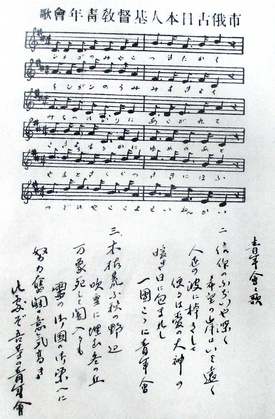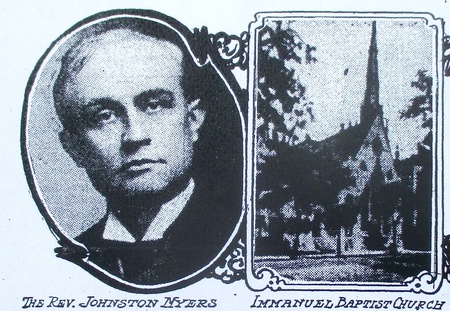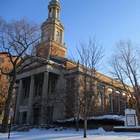The Japanese YMCA that Shimazu had taken over in 1908 had yet to realize its mission, which was to better the lives of the Japanese immigrants scattered around Chicago, in the spirit of Christianity.1 For the next thirty years, the Japanese YMCA endured many twists and turns, changing its location and name several times, but it eventually became one of the main foundations of Chicago's Japanese community.
The Japanese YMCA's thirty year history can be divided into six periods. The first period was from 1908 to 1911, when Shimazu was struggling alone in his mission work. By supporting himself with odd jobs such as janitor and houseman, Shimazu was able to continue his mission work for the Japanese, with additional support from American priests at various churches in the area. For example, the local Methodist church offered him a position as a missionary with a monthly salary of $60.00, although the offer was short-lived. Dr. E. P. Henson, pastor of the First Baptist Church,2 and Dr. Johnstone Myers, pastor of the Immanuel Baptist Church, were very helpful friends to Shimazu. Myers agreed to let Shimazu use the church’s lecture rooms for his meetings. It was in one of the back rooms of the Immanuel Baptist Church that the first religious meetings of the Japanese in Chicago were held.3 Around this time, Loring W. Messer, the general secretary of the Chicago Central Young Men's Christian Association, also became deeply interested in the work of Mr. Shimazu.4
The second period began in 1911, when Shimazu was hired by the Chicago Central YMCA. “One of Messer’s primary concerns from the time of his first coming to Chicago was that there was so little available in the city in the way of housing for transient young men. His annual reports for 1908 and 1909 listed as one of the great needs of the city: a hotel for young men coming here to seek employment.”5 Under these circumstances, “Messer was so impressed by Shimazu and his work that he recommended appropriations by the YMCA toward a salary for Shimazu in order that he might give his whole time to the work among Japanese.” Eventually, “Shimazu was listed as a Secretary of the Chicago YMCA.”6 Payment of Shimazu’s salary from the Central YMCA began in July 1911, and he earned a monthly salary of $75.00 until 1915.7

After reaching financial stability, Shimazu had the idea to buy land for farming on the shores of Lake Michigan, so that members could build healthy bodies and minds through manual labor.8 It may have been around this time that the "Japanese Song" of the Japanese YMCA was created; the song’s words were filled with the pure spirit of missionary work to build an ideal home for Japanese Christians in Chicago. One of the lines goes as follows: “With the moonlight high over Chicago and the clear water in Lake Michigan, we follow the guidance of unknown light, away from the dream of the motherland and cherry blossoms, and arrive here all together in the Japanese YMCA.”9
The Japanese YMCA moved to 3219 Groveland Avenue in November 1912.10 It was at this location that the organization was first properly recognized by the Japanese community of Chicago, likely because Shimazu had been hired as an officer in the Central YMCA. “[Shimazu] contributed to legitimize the Christianizing activities among Japanese.”11 The JYMCA published a weekly newsletter, the “Kai-Yu,”12 and established a scholarship program called the Y. Tsunekawa Loan Fund, with money collected by the Japanese Baptist Mission.13
Yohei Tsunekawa was a friend of Shimazu's who enrolled in the University of Chicago Divinity School in 1907.14 The Divinity School's roster for the 1907-08 academic year listed three other Japanese students besides Tsunekawa: Misaki Shimazu (Unclassified Divinity), Komataro Katataye (Graduate Divinity), and Katsuji Kato (English Theological Seminary). Tsunekawa was the first Japanese to teach the Japanese language at beginner and advance levels at the University of Chicago.15 He taught there for three years, but died in September 1910 in Evanston due to tuberculosis, at the very young age of 25. His older brother, Sakichi, sent a letter of appreciation for his funeral to the University of Chicago President Judson.16 A fund was later established to help students complete their education, in honor of Tsunekawa, which must have been satisfying for his dear friends, like Shimazu, who were witnesses to Tsunekawa's efforts to help others.17
In May 1914, the long-awaited First Christian Japanese Church of Chicago was organized under the auspices of the cooperative council of city missions and the Young Men’s Christian Association. The cooperative council was composed of representatives of the Baptist, Congregational, Disciples, Methodist, Episcopal, and Presbyterian denominations. Shimazu conducted the new church's first service at the First Baptist church, located on the corner of 31st Street and South Park Avenue.18
The church initially had twenty-three parishioners and grew to a congregation of fifty within six months. Prayers and services were held every Sunday at the Japanese YMCA, with more than thirty in attendance each week. Many students and graduates of the University of Chicago Divinity School helped Shimazu conduct prayers and services,19 including Katsuji Kato (who received his Ph. D in divinity in 1913),Michimasa Murakami,20 Shiko Kusama of the English Theological Seminary,21 Seiichi Murakami,22 David Yugoro Oikawa who was at the Moody Bible Institute from October 1911 to 1912,23 and Kiyoshi Yabe, who started at the University of Chicago Junior College in 190824 and finished Divinity School in 1915.25 As routine work, Shimazu continued making home visits to members of the Japanese community26 and opened his own home for church members and the Japanese YMCA to socialize at during holidays.27 Around the time that the Japanese church was established, the Japanese YMCA came to be called the Japanese Young Men’s Christian Institute (JYMCI), and had a membership of seventy-three.28
The third period of the Chicago Japanese YMCA history began in late March 1915, when the newly-named JYMCI was relocated to 2320 Calumet Avenue. The three-story red brick house had a large backyard for outdoor activities and a basement for indoor activities.29 It was here that the JYMCI adopted its basic organizational structure. According to records from June 1915, the JYMCI had eight departments: Religion, Dormitory and Employment, Literary Society, Social Service, Printing and Publication, Physical Life, Scholarship and Library. The head of Religion was Seiichi Hishikawa,30 who worked hard to build a Christian character in young Japanese men by conducting several meetings a week in Japanese, including the Sunday service, Bible study on Tuesday evenings, prayer on Thursday evenings, and Volunteer Meetings for Evangelistic Promotion.31 According to the records, Seiichi Hishikawa matriculated at the University of Chicago Divinity School in 1914,32 and earned his degree in December 1917.33
The JYMCI library held over one thousand Japanese and English books, as well as 26 different periodicals.34 It served as an information bureau about Japan for the American community, with its wealth of informational reports from Japan.35 The facility also had a tennis court, a billiard room, and other facilities for recreation,36 like Japanese fencing, or kendo. Three kendo experts led the Department of Physical Life.37
The JYMCI also functioned as an information bureau for travelers and provided assistance to Japanese tourists passing through the city.38 When Japanese community members were missing or fell sick, Shimazu searched for them or took them to the hospital.39 The JYMCI Employment Department found jobs for Japanese workers, not only in the city and across Illinois, but as far out as Gary and Michigan City in Indiana and Cedar Rapids in Iowa.40 The JYMCI frequently held lectures and literary meetings,41 given not only by students at the University of Chicago, but also by the many qualified Japanese speakers, experts in various fields, politicians and businessmen who visited Chicago and stayed at JYMCI. Additionally, a helpful neighbor taught English there every Wednesday evening.42
Shimazu’s outreach efforts included publication of the monthly bulletin “Kwai-Yu,” and visiting Japanese homes, which greatly increased the networking among Japanese Christians in Chicago and the vicinity.43 Assigned to different parts of Chicago, Japanese Christians worked on their own to recruit members; for example, Peter Yanase was assigned to West Chicago, Eiichi Haratani to the north suburbs, and Seiichi Murakami and Shimazu to South Chicago.44 They also held study meetings at their own homes frequently.
The JYMCI was at the core of the Japanese Christian community, and Consul Saburo Kurusu certainly took notice.45 Once the U.S. entered World War I in April 1917, the fourth period of JYMCI history began. Misaki Shimazu signed a new lease, with an option to purchase, on a property at 745-749 E 36th street, beginning May 1, 1917. “Ironically what brought the Institute its chance to purchase the building was a fear that swept Americans in Chicago.”46 However, the opportunity to purchase the property was in fact the beginning of the JYMCI’s downfall, and by the 1930s, the JYMCI was called a “cancer” on the Chicago Japanese community.
Notes:
1. Shimazu, Misaki, “Shikago Nihonjin Kirisuto-kyo Seinen-kai no Shimei oyobi Jigyo,” Shikago Gakuen, No. 8, 1917.
2. Hoshino, Mayumi, Strangers in the Heartland: Cultural Identity in Flux, Japanese Americans in Chicago 1892-1942, Dissertation, Indiana University, 2012, page 97.
3. The Japanese Student, January 1919.
4. Ibid.
5. Highlights on the History of the Young Men of Christian Association of Chicago 1858-1944, YMCA of Metropolitan Chicago Collection, Box 7, Folder 3, Chicago History Museum.
6. Letter of William Parker to FA Hathaway dated January 28, 1947, YMCA of Metropolitan Chicago Collection, Chicago History Museum.
7. Nichibei Shuho, May 16, 1914.
8. Nichibei Shuho, November 9, 1912.
9. Shimazu, Misaki, The Chicago Japanese YMCA Song (Post Card).
10. Nichibei Shuho, November 16, 1912.
11. Hoshino, page 104.
12. Nichibei Shuho, May 2, 1914.
13. The Japanese Student, February 1917.
14. Annual Register, 1907-1908.
15. Annual Register, 1907-1908, 1908-1909, 1909-1910.
16. The University of Chicago Office of the President, Harper, Judson and Burton Administrations Records 1869-1925, Box 53, Folder 18, Hanna Holborn Gray Special Collections Research Center, University of Chicago Library.
17. The Japanese Student, February 1917.
18. Chicago Daily Tribune, June 14, 1914.
19. Nichibei Shuho. October 17, 1914.
20. Annual Register, 1909-1910, 1910-1911, 1912-1913.
21. Annual Register, 1914-1915, 1915-1916, 1917-1918, 1918-1919.
22. Annual Register, 1913-1914, 1914-1915, 1915-1916, 1916-1917.
23. The Moody Bible Institute Student Record.
24. Annual Register, 1908-1909.
25. Annual Register, 1914-1915.
26. Shimazu, Shikago Gakuen, No. 8, 1917.
27. Nichibei Shuho, October 17, 1914.
28. Chicago Daily Tribune, June 14, 1914.
29. Nichibei Shuho, March 27, 1915.
30. Nichibei Shuho, July 17, 1915.
31. Shimazu, YMCA Report as of August 1915, YMCA of Metropolitan Chicago Collection, Chicago History Museum.
32. Annual Register, 1914-1915, 1915-1916, 1916-1917 and 1917-1918.
33. Nichibei Shuho, December 29, 1917.
34. YMCA Report as of March 1915.
35. YMCA Report as of August 1915.
36. Steiner, Jesse F. Japanese Invasion, page 141.
37. YMCA Report as of March 1915.
38. Steiner, Page 141.
39. YMCA Report as of March 1915.
40. Ibid.
41. Nichibei Shuho, August 28, 1915.
42. YMCA Report as of August 1915.
43. Nichibei Shuho, January 15, 1916.
44. Nichibei Shuho, March 13, 1915.
45. Nichibei Shuho, January 15, 1916.
46. Hoshino, page 112.
© 2021 Takako Day








